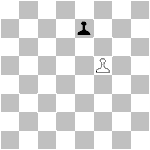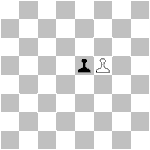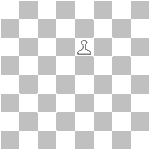At Sports&Hobbies, we're committed to delivering accurate, trustworthy information. Our expert-authored content is rigorously fact-checked and sourced from credible authorities. Discover how we uphold the highest standards in providing you with reliable knowledge.
In Chess, what is En Passant?
Chess is perhaps the most popular board game of all time. While many people are familiar with the basic rules of chess, there is one obscure move related to pawns that most players are unaware of.
Let us first review the basic rules governing the movement of pawns in chess. From their initial position, pawns are allowed to move either one or two spaces forward (provided that there are no pieces blocking their path). After being moved from their initial position, pawns can only move one space forward provided that there are no obstructing pieces.

Pawns capture opponent's pieces by moving diagonally one space. Taking en passant is an additional way that pawns are allowed to capture opponent's pawns. Suppose that the chess game has progressed and I have advanced my my pawn three spaces from its initial position (figure 1). Now consider one of the columns to the right or left of my pawn. If you advanced your pawn from its original position two squares forward, it would occupy the square next to mine (figure 2). I am allowed to move diagonally to the space behind your pawn (to the spot you would have occupied had you only moved one space forward), and capture the pawn you just moved (figure 3)! With the en passant rule, I am able to capture your pawn as if it had moved one space forward even though it moved two spaces forward. I am only allowed, however, to take your pawn en passant in the move immediately after your movement of the pawn in question.
 |
 |
 |
| figure 1 | figure 2 | figure 3 |
AS FEATURED ON:
AS FEATURED ON:











Discussion Comments
The en passant capture is compulsory when the player is in Zugzwang, and no other move is available on the board.
Annon53660, annon53588, false. No exception if pawn advances to check the opponent's king, the way you described. Also, only pawn can take a pawn "En Passant".
Just to clear this up: only a pawn can capture using the en passant rule.
a player can not call en passant on his opponent if the pawn moves two aquares past a fifth rank pawn if he is calling check on the king with the passed pawn. true or false?
note this; a opponent can not call en passant if the pawn is moved two squares passed a pawn on the fifth rank if it to call check on that opponent's king. this is the only time when en passant is overruled. the pawn is not avoiding capture, it is then checking the king to win. --Ira
According to Wikipedia, the capture can only be made with a pawn.
I think that ANY piece can capture the pawn after the pawn's initial two-space move. The point of en passant was to retain the make sure the use of the two-space move did not allow the pawn to jump past attacks that would have captured it if it took two single-space moved to make the motion. Thus en passant captures can be made with any piece.
Does the en passant rule only allow capture of the enemy pawn BY pawns or could the enemy pawn be captured by another piece whose attack it had bypassed by moving the two initial squares?
Post your comments